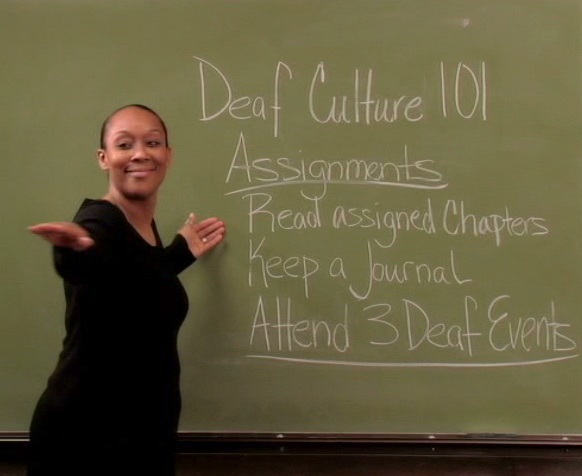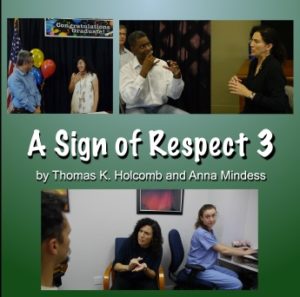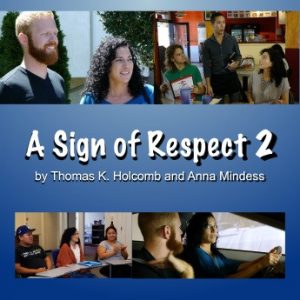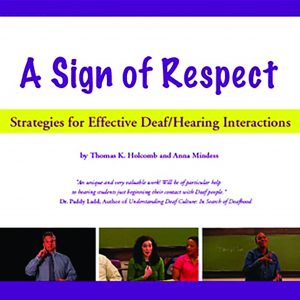Test Class
A Sign of Respect 3 – Choice Points
Select from the list below, or use the green program navigator to the right ![]() to view all of the Choice Points from “A Sign of Respect” Part 3.
to view all of the Choice Points from “A Sign of Respect” Part 3.
Part 3 (Level 3) is designed to support interpreting students as they get ready to graduate and begin their careers as professional interpreters.
A Sign of Respect 2 – Choice Points
Select from the list below, or use the green program navigator to the right ![]() to view all of the Choice Points from “A Sign of Respect” Part 2.
to view all of the Choice Points from “A Sign of Respect” Part 2.
Part 2 (Level 2) is designed for advanced and more experienced ASL students.
APPENDIX – Videos Only
This section provides direct access to all the video clips in this program.
Select from the list below, or use the green program navigator to the right ![]() to view individual videos from “A Sign of Respect” Part 1.
to view individual videos from “A Sign of Respect” Part 1.
The videos are listed in the order they appear in the program.
Below each video there are links to the exercises and readings associated the video. Be sure to scroll down to see the links.
For exercises, select the button to download the exercise file.
The exercise file will open in a new window on your browser. Download the file to your computer. If necessary, select “Enable Editing” in your word processing program. Complete the exercise, save it to your computer, then follow your instructor’s directions to submit it.
For your convenience, we have also compiled all the exercises for the entire program into one file.
Select the button below to download it.
UNIT 12 – Wrapping Up
 This is the last unit of the curriculum.
This is the last unit of the curriculum.
You will review what you have learned thus far about Deaf culture.
UNIT 11 – Becoming an Ally

Here, in this unit, you will examine what it takes to be an ally of the Deaf community.
UNIT 10 – Developing Friendships

Friendship is a two-way street.
As is true with any cross-cultural situations, successful negotiation between two “worlds” and cultures can be tricky.
UNIT 9 – Initiating Relationships

In this unit, you will consider ways to make the first step to become involved in the Deaf community.
UNIT 8 – Accepting Feedback/Handling Straight Talk

Straight talk is one hallmark of the Deaf community.
In this unit, you will learn why straight talk is of value to many Deaf people.
UNIT 7 – Learning the Basics of Deaf Culture
 Now that you have attended your first Deaf community event, hopefully you are eager for your next experience.
Now that you have attended your first Deaf community event, hopefully you are eager for your next experience.
Here, you will learn some of the basic elements of Deaf culture.
UNIT 6 – Meeting Deaf People

The next challenge after making it to the Deaf event is to have positive interactions with Deaf people.
In this unit, you will learn different ways to initiate conversations.
UNIT 5 – Displaying Appropriate Behaviors at Deaf Events

As is true for any new experience, it can be intimidating attending a Deaf community event.
You will be provided with some tips on how to manage potentially awkward situations you might encounter at the Deaf event.
UNIT 4 – Attending Your First Deaf Event

As ASL students attending events sponsored by the Deaf community, it is important to recognize that you are guests there and that you need to exhibit a respectful attitude while participating in the experience.
UNIT 3 – Learning More About Deaf Events

In most ASL programs, students are expected to attend events where ASL is used.
In this unit, you will learn more about the Deaf community and factors that should be considered in choosing events to attend.
UNIT 2 – Having a Deaf or Signing Instructor

For some of you, it will be a new experience being in a learning environment where ASL is the primary language of instruction.
In this unit, you will examine issues associated with being in a signing classroom.
UNIT 1 – Learning More About The Deaf Community

This is the first unit of “A Sign of Respect” Part 1.
Here, Tom explains the purpose and contents of this curriculum.
A Sign of Respect 1 – Choice Points
Select from the list below, or use the green program navigator to the right ![]() to view all of the Choice Points from “A Sign of Respect” Part 1.
to view all of the Choice Points from “A Sign of Respect” Part 1.
Part 1 (Level 1) is designed for beginning ASL students.
DEMO A Sign of Respect – Part 3 (Level 3)
Welcome to the Part 3 (Level 3) DEMO version of the A Sign of Respect series!
Part 3 (Level 3) is geared toward students soon to graduate from Interpreter Preparation Programs.
Teachers only: Click “Contact” at the top of this page to request a free trial!
DEMO A Sign of Respect – Part 2 (Level 2)
Welcome to the Part 2 (Level 2) DEMO version of the A Sign of Respect series!
Part 2 (Level 2) is intended for advanced ASL or beginning interpreting students.
Teachers only: Click “Contact” at the top of this page to request a free trial!
DEMO A Sign of Respect – Part 1 (Level 1)
Welcome to the Part 1 (Level 1) DEMO version of the A Sign of Respect series!
Part 1 (Level 1) is intended for beginning students (ASL 1 or 2).
Teachers only: Click “Contact” at the top of this page to request a free trial!
APPENDIX – Videos Only (Under Construction)
This section provides direct access to all the video clips in this program.
Select from the list below, or use the green program navigator to the right ![]() to view individual videos from “A Sign of Respect” Part 3.
to view individual videos from “A Sign of Respect” Part 3.
The videos are listed in the order they appear in the program.
Below each video there are links to the exercises and readings associated the video. Be sure to scroll down to see the links.
For exercises, select the blue button to download the exercise file.
The exercise file will open in a new window on your browser. Download the file to your computer. If necessary, select “Enable Editing” in your word processing program. Complete the exercise, save it to your computer, then follow your instructor’s directions to submit it.
For your convenience, we have also compiled all the exercises for the entire program into one file.
Select the button below to download it.




